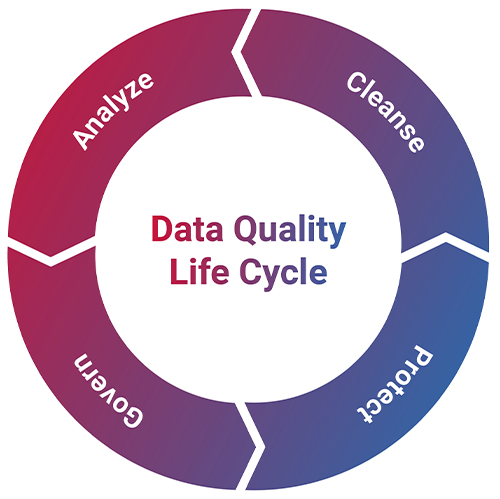Why good data quality management should be a continuous process

"Panta rhei - everything flows ..." this aphorism of the Greek philosopher Heraclitus is especially true for the area of customer master data. Changes and updates occur almost continuously, which must of course be taken into account on an ongoing basis in order to maintain the quality of customer master data at a high level. For this reason, all measures aimed at ensuring better quality customer data with a one-off action are doomed to failure from the outset. Instead, it is necessary to define and implement a continuous "cycle" of measures for data quality management, with which the quality of the data is successively and sustainably improved.
It is undisputed that such a successive and sustainable optimization of customer master data is absolutely necessary today. No company can or wants to afford poorly maintained customer data.
Data of appropriate quality, on the other hand, is the key success factor:
- for a 360-degree view of the custmoer as an important prerequisite
- for the planning and execution of marketing and sales campaigns,
- for support and customer service tailored to the customer's needs,
- for products and services perfectly adapted to their needs,
- for meeting compliance and regulatory requirements (e.g in banking and finance)
- for correct strategic business decisions based upon predictive analytics methods.
Data quality management for customer master data:
Nothing is more constant than change
If most companies are aware of the importance of professional data quality management, the question naturally arises as to why many companies still fail to sustainably maintain the quality of their customer master data at a high level.
First of all, of course, this is in the nature of things. Today, personal data such as addresses or telephone numbers are subject to almost constant change. This is underlined by the following figures alone:
- Every year, eight million people move in Germany.
- Every year, there are more than 800,000 deaths in Germany.
- Every year, 45,000 street names and almost 2,000 place names are renamed in Germany.
In the business-to-business sector, insolvencies (nearly 14,600 companies in 2022), company acquisitions and mergers, and employee changes make for constantly changing company and address data.
Other factors that can influence the quality of customer master data are:
- Incorrect information provided by the customer in direct contact (mail, telephone, online form)
- Errors in data entry by an employee
- Entering and maintaining data in isolated data silos (ERP system, online store, ticketing system)
On the one hand, this leads to a customer data "uncontrolled growth", which even today can hardly or not at all be managed by many companies, i.e. consolidated in a central database. But the following applies: Without consolidation in the context of data quality management, there is no optimization of the quality of the data.
But even consolidation alone does not necessarily lead to better data. It must be supplemented by other measures. In doing so, it is necessary to integrate the individual measures into a continuous cycle. Only then can the continuous changes be managed.
The cycle for data quality management
The cycle for data quality management is the basis for sustainable optimization of customer master data. It illustrates once again that this is not a one-off ad hoc action. Instead, a "closed loop" involves a bundle of measures that are seamlessly interlinked and for which there is in principle no beginning and no end.

The Data Quality Life Cycle consists of the following four phases:
- Analyze
Overview of the ACTUAL state of the customer master data available in the company and uncovering of deficits, inconsistencies and violations of specifications for data collection.
- Cleanse
Measures to eliminate the errors and deficits identified in phase 1 and to optimize data quality. Consolidate and enrich the available master data to create a "golden record".
- Protect
Long-term and sustainable maintenance of a high level of data quality by setting up "DQ checks". This prevents "creeping contamination" of the data. "First Time Right" by setting up a DQ firewall.
- Govern
Continuous monitoring and documentation of data quality, e.g. via a DQ scorecard. The results then again form the basis for a renewed analysis of data quality, thus closing the loop for data quality management.
Beyond data quality management, discover the four levels of data quality in our whitepaper. Is your data fit for purpose?
The four levels of data quality
We will show you four steps that must be taken into account when it comes to the quality of the data so that it ultimately becomes a real asset for your company. Only the best for your data.
Download the Uniserv Business Whitepaper now.
The Golden Record is good, the 360 degree view is better
More and more companies are recognizing the central importance of having the most up-to-date, precise, complete and correct 360-degree customer view possible for their future business success. However, the customer master data collected in the company alone is no longer sufficient for this. Because in these times of ever more rapid digitization of the customer, the customer leaves behind a whole series of "traces". These traces are created not only at the company's many touchpoints (website, online store, newsletter, etc.), but also in online communities, rating portals, and social media, which must also be included in the 360-degree view.

Conclusion:
If you want to increase the quality of your customer data and maintain it at a high level on an ongoing basis, you must not regard this task as a "one-off action". Rather, it is important to ensure that a continuous cycle for data quality management consisting of seamlessly interlocking measures is implemented, ideally throughout the company. Only then will the challenge of sustainably appropriate data quality be successfully mastered. With reliable data, it is also possible to form the so-called Golden Profile of each customer. This is rounded off with continuous data quality management in a closed loop - and nothing stands in the way of professional customer data management for a successful customer journey.
You might also be interested in:



